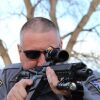I have been privileged to teach firearms to both law enforcement officers and private citizens. One of the advantages to teaching non-sworn folks is I see a greater variety of students in stature and ability in those classes.
The prototypical police recruit is enthusiastic, youthful, fit and generally average sized. However, the last several years it has become much more common to come across recruits with very small hands, especially females, who have trouble with duty-size handguns.
Thankfully, teaching on the private side has given me the opportunity to learn about the importance of a firearm that fits the shooter. Handguns are especially difficult for folks with very small hands. More and more, we see very small folks, especially females, entering law enforcement. Law enforcement’s double-stack 17-round duty guns are simply too large for them.
Gun fit
How do you know if your officers are having trouble with gun fit? The most common way to measure a pistol grip to the shooter’s hand is this: The backstrap of the pistol must be reasonably aligned with the web of the hand coming straight back to forearm while the second knuckle of the fingers of the firing hand remain under the trigger guard.
The recruits I’ve seen have difficulty could only maintain that grip for a few rounds before the pistol twisted in their hand leaving only their thumb to control recoil. Imagine trying to hold onto a four-foot-long 2x4 while someone yanks back and forth on it. That’s what small-pawed recruits face when firing a typical duty pistol. Those physical features make it difficult for them to qualify, which is detrimental to their success and their confidence.
Attempted fixes
When a recruit has difficulty shooting the issued duty pistol, I bring a few guns from home for them to try. Even the models with interchangeable backstraps were too big for a few of our female recruits. There is a pistol on the market that works for these folks, though. Its capacity is only 10+1 rounds in 9mm but is much more user friendly to our more diminutive cops. Recruits shoot much more accurately and comfortably with these pistols.
Fortunately, our department is small enough and progressive enough we can make important policy changes like this one within a matter of days. Still, the lower capacity gives me pause. We recently saw a law enforcement shooting where the assailant kept advancing on an officer after receiving 11 rounds to the upper torso.
Plus
When I recently had the opportunity to review the Smith & Wesson M&P Shield Plus 3.1” barrel, which has a magazine capacity of 13 rounds, I had an unconventional thought. I often recommend a Shield to my private students and with the introduction of the Shield Plus, I’m certain I will do so even more enthusiastically. However, the more common 3.1” barreled Shield is certainly not acceptable for a duty gun due to the short sight radius. Cops are much more likely to have the need to shoot at distance and a 4” barrel is widely considered the minimum for police work.
[DOWNLOAD: How to buy firearms eBook]
Plus Radius
However, one version of the Shield Plus has a 4" barrel. Another variation is even set up for a Mini-Red Dot Sight (MRDS). A gun with 4” barrel and 13+1 magazine is perfectly suitable for a duty gun despite its small size with or without an MRDS.
Smith & Wesson was kind enough to send a Performance Center Shield Plus with a 4-inch barrel, fiber optic sights and a Crimson Trace MRDS for testing and review. I enlisted the help of one of our female recruits, “Officer R,” who is just out of training to help test my theory. Her miniscule mitts made it difficult for her to effectively shoot a full-size duty pistol during her academy training.
Gun test
Before doing that, though, I decided to put the Shield Plus through its paces. I attended four full days of training with two different instructors over the few months after I received the Plus for review.
I let eight different people shoot it including Spencer Keepers, who is widely considered one of the best defensive shooters and instructors in the country. All were impressed with its handling and capacity. Over the two-month period, the Plus handled about 400 rounds of miscellaneous practice ammunition and 100 rounds of Federal 124 grain +P HST without issue.
Small hands with the Plus
Having done my due diligence in testing the Shield Plus, I asked Officer R to meet me at the range. We didn’t do much warm-up since “R” was on duty.
Officer R handled the Shield Plus better than anything else we’d put in her hands. I helped set her grip correctly one time and put her to the task of firing the gun at whatever pace she chose. She fired one. Then another. Then, several. I attempted to catch the muzzle rise on camera (that’s a thing we gun writers do), but I couldn’t.
Every time R fired the Plus, she was able to follow through and get the gun immediately back on target. I saw a sense of relaxation from Officer R I hadn’t seen from her in the firearms portion of the academy. This gun fit her hands and her confidence was palpable.
A Shield duty pistol?
I’m not sure we are ready to adopt the Shield Plus as a duty pistol. That isn’t what it was designed for. Still, as we are seeing firearms capacity technology advance, I am excited to see where it leads for future cops. There’s a lot for them to struggle with in the current environment and a pistol that fits their hands properly would be one less thing.
NEXT: Why firearms standardization puts police officers at risk



